Having arrived a little early for Week 6 of our Team CASPA project at the Museum of London, I decided to begin the day having a little root around in the documentation that accompanied the dig at Fulham Pottery. Excavations began in 1971 and there are some wonderful black and white photos that give a sense of the pottery in action. I loved having a chance to glance through the documents, even coming across the original Fulham Pottery Logo. It really gave me a reminder of the business side and legacy of John Dwight’s work. It also gives you an indication of the scope of the work involved in an archaeological dig with pages and pages of detailed notes and descriptions.
I also came across some interesting letters that showed a number of pieces from the site had been loaned to the V&A Museum. This week I have had a chance to search their collections to see if they had any material similar to the types of medallions we have been handling each week.
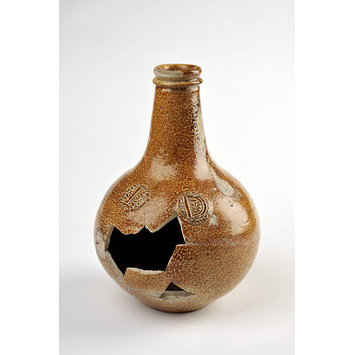
Decanter bottle © Victoria and Albert Museum, London http://collections.vam.ac.uk/item/O297130/decanter-bottle-john-dwights-fulham/
There were some fantastic, near-complete, examples of John Dwight’s pottery on the V&A collections online website. I came across a beautiful decanter on loan from the Museum of London with two letter medallions very similar to the ones we have been looking at. This particular bottle is on display in the Ceramics Gallery, there was also a saggar, saggar cover and kiln spacer also from the Museum of London. John Dwight used the saggars from about 1680 to protect the pottery from direct contact with the flames and enabled the kiln to be stacked efficiently.
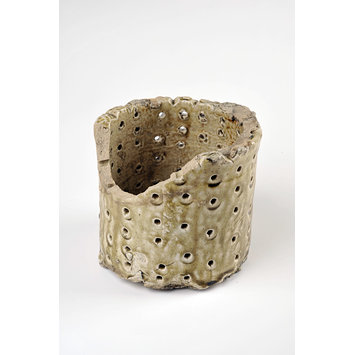
Saggar © Victoria and Albert Museum, London http://collections.vam.ac.uk/item/O297124/saggar-john-dwights-fulham/
Having detailed information and good quality images is ideal for researchers and nosey online visitors just like me who might have an interest in a particular topic. Museums have so many objects in their collections it is not always possible to find images of what you are looking for. In this instance I was lucky probably because these items are on display and they have been photographed as part of that process.
You are probably wondering how this relates to the work Team CASPA are doing, well this week our group have been leaving the re-packing to focus on a little photography work of their own. We have been revisiting the bags we have already excellently repacked and taking reference photos of the contents that will eventually be added to the Museum of London database. Using iPads we have concentrated on laying objects out as they would have been in a complete state, rims to the top, bases at the bottom and medallions in the middle.
Trying to orientate the medallions the right way up is often tricky as the pieces we have are usually incomplete but the detailed drawings in the documentation help us. It is harder than you would think as some bags have multiple pieces of different sizes and rest at different angles but using folded paper props makes it a little easier.
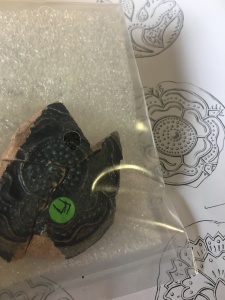
Matching medallions to documentations
As good as these photos are they will only be used for reference. The quality is not good enough to go on the public-facing collections online. The photos for collections online are usually taken by the museum photographer. On another project I worked with a curator and the photographer to capture a number of items recovered from the Thames foreshore in the 1980s. Most of the items related to the 18th century ship building trade and included tools, nails and some wonderful padlocks.
Deciding how to photograph an object can really affect how we see it and gives ideas on how it was used.
I had never realised how complex photographing museum objects was before this project. Do we photograph padlocks open or closed? Should a nail be photographed horizontally or vertically? How do you show that a marlinspike is a tool, not a nail? Do you photograph it in a different way? We had to note down how we wanted each item to be photographed making sure our methods were consistently applied. We also had to make sure any special markings were included in the photos, sometimes taking up to three photographs for one object.
Our list of instructions and well thought out plans of how we wanted each object to be photographed then had to fit with how the photographer needed to work to maximise efficiency. Over two days we worked as a production line getting objects out, photographing them, adding metadata to the photographs and then carefully repacking them away again. It is fantastic to now see these up on the Museum of London collections online page and you can see some of them here – http://collections.museumoflondon.org.uk/online/search/#!/results?pageSize=35&page=3&terms=foreshore
With these photos you can see some of the digitising process – adding metadata, taking close up pictures of details and the curator working with Museum of London photographer.
Museums don’t often have the time or resources to photograph every object in their collection but working with volunteers is a great way to open up access to objects via the internet whilst also giving volunteers the opportunity to get hands on with objects.
Here you can see the difference in quality between my reference photo top left and the museum photograph on collections online. There is also a close up photo of the detail. http://collections.museumoflondon.org.uk/online/object/281606.html Copyright Museum of London
Whilst the photos Team CASPA took on Week 6 won’t be accessible to the public, they will be accessible to museum staff via the internal catalogue. Allowing them to get a sense of the objects from the Fulham site held in the museum archive in Hackney whilst they sit at their desks at the museum site at London Wall. All this work is providing the stepping stones to sharing objects that came out of the ground in 1971 to museum visitors across the world in the 21st century.
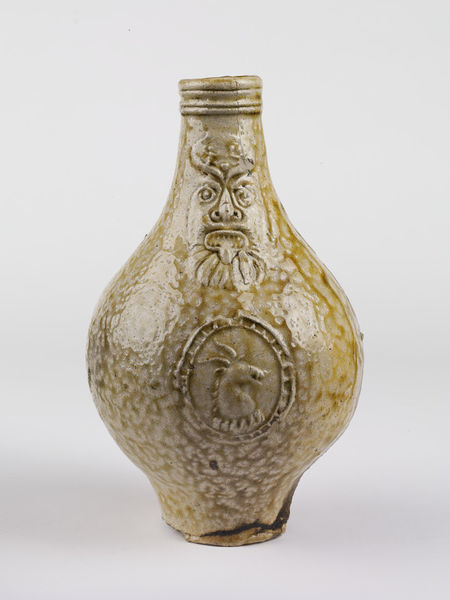
Bottle © Victoria and Albert Museum, London http://collections.vam.ac.uk/item/O188175/bottle-john-dwights-fulham/
As I compared online collections at the Museum of London and the V&A for this blog I came across another fantastic John Dwight bottle featuring a bearded man and goat relief, this particular example made by Dwight’s factory around 1680 but given by Lady Charlotte Schreiber and not loaned from the Museum of London.
I wonder how the bottle came into her collection and the route it took to be reunited with other Fulham Pottery pieces at the V&A. A bit more digging and I find she, along with her second husband, collected European ceramics which she then donated to the museum.
I even came across her journals digitised on the archive.org website, with a wonderful extract on how she came across some stoneware in a museum in Germany in 1879.
Tuesday, 21st. We were out soon after 10 this morning. I went first to Weiss’s to look again at some Oriental vases he offers us for sale, and then proceeded to the Griine Gewolbe (Grünes Gewölbe), where we spent two hours with the usual pleasure. Paid a visit there to the Director, Grasse, and got from him an order to see the Porcelain Museum, which is now closed to the public, and undergoing its annual cleansing. Here we spent another two hours in great bliss. There is little more for me to remark about this wonderful collection. I know it well, and love it well, but on looking at the small number of pieces which re-present English Ware in it, I was surprised to find that so many of them were glaze stoneware, mostly very interesting specimens. There are three mugs of the ‘Midnight Conversation”, one of which is of the same crisp quality as ours, and the other two of a darker and coarser texture. There are also two groups of figures, most quaint and original, which are very possible of Fulham manufacture.1
Her Catalogue of English porcelain donated to the museum in 1884 is also on archive.org and in it she goes on further to mention Dwight and the Fulham Pottery. Now I wonder if the bottle came from the ‘Walled-up Chamber’.
“..among the old ledgers in his office, and discovered the valuable note-books of Dwight himself, containing his recipes for making ‘white transparent porcelain’, ‘marbled porcelain,’ etc, bearing dates of 1689-1698.
Mr Bailey presented us with some specimens which had been found in the oft-cited ‘Walled-up Chamber’ at Fulham, which were supposed to have remained there undisturbed since the time of Dwight”. viii preface 2
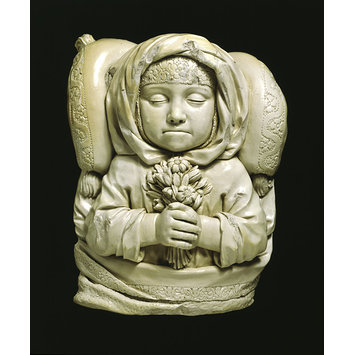
© Victoria and Albert Museum, London http://collections.vam.ac.uk/item/O77368/lydia-dwight-dead-figure-john-dwights-fulham/
It is why I love searching on museum collections online, why it always tells you more of the story. In my final search of the V&A collections I came across a stoneware statue of Lydia Dwight, John Dwight’s daughter. She was just 6 when she died in 1674. The record notes the object was commissioned by Dwight in order to capture his daughter’s likeness and perpetuate her memory. It seems so strange to come across something in stoneware so personal relating to Dwight when each week we actually deal with the everyday commercial side of his work. It makes you remember the man behind Fulham Pottery and the scraps of broken pot we have spent all day photographing.
Team CASPA are very much a part of keeping the story of Fulham Pottery alive, allowing people like me to stumble across the story of John Dwight. Along with new skills in the workplace, the legacy of their work at the Museum of London will go on long past the short few weeks of this project.
xxxxxxxxxxxxxxxx
You can find our more about Team CASPA on my previous blogs – https://tinctureofmuseum.wordpress.com/?s=teamcaspa
1 – Lady Charlotte Schreiber’s journals: confidences of a collector of ceramics & antiques throughout Britain, France, Holland, Belgium, Spain, Portugal, Turkey, Austria & Germany from the year 1869-1885, p233, archive.org, [accessed 7 June 2017] https://archive.org/stream/ladycharlottesch02schr/ladycharlottesch02schr_djvu.txt
2 – Catalogue of Schreiber Collection of English Porcelain, Earthenware, Enamels etc., preface iiiv, archive.org, [accessed 7 June 2017] https://archive.org/stream/catalogueofengli00victuoft/catalogueofengli00victuoft_djvu.txt




